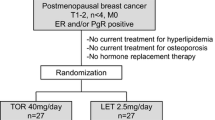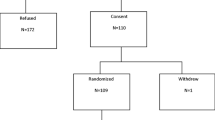Abstract
We hypothesized that exemestane (EXE) would reduce mammographic breast density and have unique effects on biomarkers of bone and lipid metabolism. Healthy postmenopausal women were randomized to EXE (25 mg daily) or placebo (PLAC) for 12 months and followed for a total of 24 months. The primary endpoint was change in percent breast density (PD) between the baseline and 12-month mammograms and secondary endpoints were changes in serum lipid levels, bone biomarkers, and bone mineral density (BMD). Ninety-eight women were randomized (49 to EXE; 49 to PLAC) and 65 had PD data at baseline and 12 months. Among women treated with EXE, PD was not significantly changed from baseline at 6, 12, or 24 months and was not different from PLAC. EXE was associated with significant percentage increase from baseline in N-telopeptide at 12 months compared with PLAC. No differences in percent change from baseline in BMD (lumbar spine and femoral neck) were observed between EXE and PLAC at either 12 or 24 months. Patients on EXE had a significantly larger percent decrease in total cholesterol than in the PLAC arm at 6 months and in HDL cholesterol at 3, 6, and 12 months. No significant differences in percent change in LDL or triglycerides were noted at any time point between the two treatment arms. EXE administered for 1 year to healthy postmenopausal women did not result in significant changes in mammographic density. A reversible increase in the bone resorption marker N-telopeptide without significant change in bone specific alkaline phosphatase or BMD during the 12 months treatment period and 1 year later was noted. Changes in lipid parameters on this trial were modest and reversible.
Similar content being viewed by others
References
Greendale GA, Reboussin BA, Sie A, Singh HR, Olson LK, Gatewood O et al (1999) Effects of estrogen and estrogen-progestin on mammographic parenchymal density. Postmenopausal estrogen/progestin interventions (PEPI) investigators. Ann Intern Med 130(4 Pt 1):262–269
Knight JA, Martin LJ, Greenberg CV, Lockwood GA, Byng JW, Yaffe MJ et al (1999) Macronutrient intake and change in mammographic density at menopause: results from a randomized trial. Cancer Epidemiol Biomarkers Prev 8(2):123–128
Boyd NF, Byng JW, Jong RA, Fishell EK, Little LE, Miller AB et al (1995) Quantitative classification of mammographic densities and breast cancer risk: results from the Canadian National Breast Screening Study. J Natl Cancer Inst 87(9):670–675
Boyd NF, Guo H, Martin LJ, Sun L, Stone J, Fishell E et al (2007) Mammographic density and the risk and detection of breast cancer. N Engl J Med 356(3):227–236
Boyd NF, Rommens JM, Vogt K, Lee V, Hopper JL, Yaffe MJ et al (2005) Mammographic breast density as an intermediate phenotype for breast cancer. Lancet Oncol 6(10):798–808
Byrne C, Schairer C, Brinton LA, Wolfe J, Parekh N, Salane M et al (2001) Effects of mammographic density and benign breast disease on breast cancer risk (United States). Cancer Causes Control 12(2):103–110
Byrne C, Schairer C, Wolfe J, Parekh N, Salane M, Brinton LA et al (1995) Mammographic features and breast cancer risk: effects with time, age, and menopause status. J Natl Cancer Inst 87(21):1622–1629
Harvey JA, Bovbjerg VE (2004) Quantitative assessment of mammographic breast density: relationship with breast cancer risk. Radiology 230(1):29–41
McCormack VA, dos Santos Silva I (2006) Breast density and parenchymal patterns as markers of breast cancer risk: a meta-analysis. Cancer Epidemiol Biomarkers Prev 15(6):1159–1169
Ursin G, Ma H, Wu AH, Bernstein L, Salane M, Parisky YR et al (2003) Mammographic density and breast cancer in three ethnic groups. Cancer Epidemiol Biomarkers Prev 12(4):332–338
Wolfe JN, Saftlas AF, Salane M (1987) Mammographic parenchymal patterns and quantitative evaluation of mammographic densities: a case–control study. AJR Am J Roentgenol 148(6):1087–1092
Biong M, Gram IT, Brill I, Johansen F, Solvang HK, Alnaes GI et al (2010) Genotypes and haplotypes in the insulin-like growth factors, their receptors and binding proteins in relation to plasma metabolic levels and mammographic density. BMC Med Genomics 3:9
Boyd NF, Stone J, Martin LJ, Jong R, Fishell E, Yaffe M et al (2002) The association of breast mitogens with mammographic densities. Br J Cancer 87(8):876–882
Diorio C, Brisson J, Berube S, Pollak M (2008) Genetic polymorphisms involved in insulin-like growth factor (IGF) pathway in relation to mammographic breast density and IGF levels. Cancer Epidemiol Biomarkers Prev 17(4):880–888
Taverne CW, Verheus M, McKay JD, Kaaks R, Canzian F, Grobbee DE et al (2010) Common genetic variation of insulin-like growth factor-binding protein 1 (IGFBP-1), IGFBP-3, and acid labile subunit in relation to serum IGF-I levels and mammographic density. Breast Cancer Res Treat 123(3):843–855
Warren R, Skinner J, Sala E, Denton E, Dowsett M, Folkerd E et al (2006) Associations among mammographic density, circulating sex hormones, and polymorphisms in sex hormone metabolism genes in postmenopausal women. Cancer Epidemiol Biomarkers Prev 15(8):1502–1508
Cyrlak D, Wong CH (1993) Mammographic changes in postmenopausal women undergoing hormonal replacement therapy. AJR Am J Roentgenol 161(6):1177–1183
Rutter CM, Mandelson MT, Laya MB, Seger DJ, Taplin S (2001) Changes in breast density associated with initiation, discontinuation, and continuing use of hormone replacement therapy. JAMA 285(2):171–176
Stomper PC, Van Voorhis BJ, Ravnikar VA, Meyer JE (1990) Mammographic changes associated with postmenopausal hormone replacement therapy: a longitudinal study. Radiology 174(2):487–490
Atkinson C, Warren R, Bingham SA, Day NE (1999) Mammographic patterns as a predictive biomarker of breast cancer risk: effect of tamoxifen. Cancer Epidemiol Biomarkers Prev 8(10):863–866
Brisson J, Brisson B, Cote G, Maunsell E, Berube S, Robert J (2000) Tamoxifen and mammographic breast densities. Cancer Epidemiol Biomarkers Prev 9(9):911–915
Chow CK, Venzon D, Jones EC, Premkumar A, O’Shaughnessy J, Zujewski J (2000) Effect of tamoxifen on mammographic density. Cancer Epidemiol Biomarkers Prev 9(9):917–921
Cuzick J, Warwick J, Pinney E, Warren RM, Duffy SW (2004) Tamoxifen and breast density in women at increased risk of breast cancer. J Natl Cancer Inst 96(8):621–628
Konez O, Goyal M, Reaven RE (2001) Can tamoxifen cause a significant mammographic density change in breast parenchyma? Clin Imaging 25(5):303–308
Son HJ, Oh KK (1999) Significance of follow-up mammography in estimating the effect of tamoxifen in breast cancer patients who have undergone surgery. AJR Am J Roentgenol 173(4):905–909
Ursin G, Pike MC, Spicer DV, Porrath SA, Reitherman RW (1996) Can mammographic densities predict effects of tamoxifen on the breast? J Natl Cancer Inst 88(2):128–129
Cuzick J, Warwick J, Pinney L et al (2008) Change in breast density as a biomarker of breast cancer risk reduction; results from IBIS-1. In: Abstract #61. Presented at the 2008 annual San Antonio breast cancer symposium, 2008
Dowsett M, Jones A, Johnston SR, Jacobs S, Trunet P, Smith IE (1995) In vivo measurement of aromatase inhibition by letrozole (CGS 20267) in postmenopausal patients with breast cancer. Clin Cancer Res 1(12):1511–1515
Geisler J (2003) Breast cancer tissue estrogens and their manipulation with aromatase inhibitors and inactivators. J Steroid Biochem Mol Biol 86(3–5):245–253
Miller WR, Dixon JM (2001) Local endocrine effects of aromatase inhibitors within the breast. J Steroid Biochem Mol Biol 79(1–5):93–102
Cigler T, Tu D, Yaffe MJ, Findlay B, Verma S, Johnston D et al (2010) A randomized, placebo-controlled trial (NCIC CTG MAP1) examining the effects of letrozole on mammographic breast density and other end organs in postmenopausal women. Breast Cancer Res Treat 120(2):427–435
Vachon CM, Ingle JN, Suman VJ, Scott CG, Gottardt H, Olson JE et al (2007) Pilot study of the impact of letrozole vs. placebo on breast density in women completing 5 years of tamoxifen. Breast 16(2):204–210
Jong R, Fishell E, Little L, Lockwood G, Boyd NF (1996) Mammographic signs of potential relevance to breast cancer risk: the agreement of radiologists’ classification. Eur J Cancer Prev 5(4):281–286
Byng JW, Boyd NF, Fishell E, Jong RA, Yaffe MJ (1994) The quantitative analysis of mammographic densities. Phys Med Biol 39(10):1629–1638
Fabian CJ, Kimler BF, Zalles CM, Khan QJ, Mayo MS, Phillips TA et al (2007) Reduction in proliferation with six months of letrozole in women on hormone replacement therapy. Breast Cancer Res Treat 106(1):75–84
Becker S, Kaaks R (2009) Exogenous and endogenous hormones, mammographic density and breast cancer risk: can mammographic density be considered an intermediate marker of risk? Recent Results Cancer Res 181:135–157
Martin LJ, Minkin S, Boyd NF (2009) Hormone therapy, mammographic density, and breast cancer risk. Maturitas 64(1):20–26
Barni S, Lissoni P, Meregalli S, Ardizzoia A, Mengo S, Musco F et al (1998) Clinical efficacy of the aromatase inhibitor anastrozole in relation to prolactin secretion in heavily pretreated metastatic breast cancer. Tumori 84(1):45–47
Harper-Wynne C, Ross G, Sacks N, Salter J, Nasiri N, Iqbal J et al (2002) Effects of the aromatase inhibitor letrozole on normal breast epithelial cell proliferation and metabolic indices in postmenopausal women: a pilot study for breast cancer prevention. Cancer Epidemiol Biomarkers Prev 11(7):614–621
Lonning PE, Geisler J, Krag LE, Erikstein B, Bremnes Y, Hagen AI et al (2005) Effects of exemestane administered for 2 years versus placebo on bone mineral density, bone biomarkers, and plasma lipids in patients with surgically resected early breast cancer. J Clin Oncol 23(22):5126–5137
Perez EA, Josse RG, Pritchard KI, Ingle JN, Martino S, Findlay BP et al (2006) Effect of letrozole versus placebo on bone mineral density in women with primary breast cancer completing 5 or more years of adjuvant tamoxifen: a companion study to NCIC CTG MA.17. J Clin Oncol 24(22):3629–3635
Wasan KM, Goss PE, Pritchard PH, Shepherd L, Palmer MJ, Liu S et al (2005) The influence of letrozole on serum lipid concentrations in postmenopausal women with primary breast cancer who have completed 5 years of adjuvant tamoxifen (NCIC CTG MA.17L). Ann Oncol 16(5):707–715
Acknowledgments
Paul Goss is supported in part by The Avon Foundation, New York. This project was supported by Pfizer Inc and the Canadian Cancer Society. We are also indebted to the hardworking investigators and staff at the participating MAP.2 centres and to all the women who generously agreed to participate in this trial.
Author information
Authors and Affiliations
Corresponding author
Rights and permissions
About this article
Cite this article
Cigler, T., Richardson, H., Yaffe, M.J. et al. A randomized, placebo-controlled trial (NCIC CTG MAP.2) examining the effects of exemestane on mammographic breast density, bone density, markers of bone metabolism and serum lipid levels in postmenopausal women. Breast Cancer Res Treat 126, 453–461 (2011). https://doi.org/10.1007/s10549-010-1322-0
Received:
Accepted:
Published:
Issue Date:
DOI: https://doi.org/10.1007/s10549-010-1322-0




